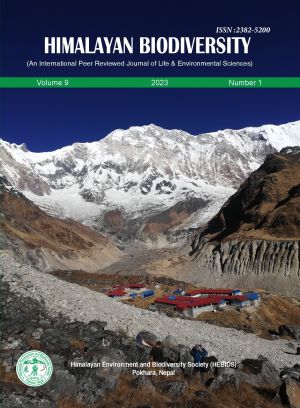Evaluating the Major Sources of Surface Water Quality in Pokhara Metropolitan City, Gandaki Province, Nepal
DOI:
https://doi.org/10.3126/hebids.v9i1.59584Keywords:
Water quality assessment, Hydrochemistry, Total coliform, Pokhara, Mardi watershedAbstract
The Mardi Watershed serves as a crucial source of drinking water for Pokhara Metropolitan City (PMC), Gandaki Province, Nepal, offering a wide range of ecosystem services including fishing, tourism, transportation, livestock support, and, notably, clean drinking water. However, the main river and its tributaries face degradation due to a blend of human and natural impacts. This comprehensive study rigorously examines the physicochemical and biological attributes that define water quality within the watershed. Recognizing the global importance of water quality for human well-being, this investigation specifically evaluates the suitability of water for drinking purposes. Twenty-three samples were collected and subjected to analysis for the twenty-one distinct physicochemical parameters. The analysis covers physicochemical parameters such as pH, water temperature, conductivity, total dissolved solids, alkalinity as well as concentrations of ions such as calcium (Ca2+), magnesium (Mg2+), sodium (Na+), potassium (K+), ammonium (NH4+), nitrate (NO3-), bicarbonate (HCO3-), sulfate (SO42-), and phosphate (PO43-), free carbon dioxide (CO2), chloride (Cl-), total hardness (TH), calcium hardness (CaH), magnesium hardness (MgH), iron (Fe2+), turbidity (Turb.) Simultaneously, biological markers including total coliforms were assessed. The overall water quality aligns with the World Health Organization (WHO) guidelines, a significant exception lies in microbial indicators. Microbial presence, likely a result of increasing anthropogenic pressures, is relatively elevated in most samples. Furthermore, the cumulative outcome reveals a Water Quality Index (WQI) of 22.04, indicating excellent suitability for drinking. Since, effective management strategies are crucial for ensuring a consistent and sustainable supply of potable water to the urban population, information obtained through this study can contribute to the sustainable management of water quality and maintaining a reliable supply of safe drinking water to urban communities.
Downloads
Downloads
Published
How to Cite
Issue
Section
License
© Himalayan Environment and Biodiversity Society (HEBIDS)

